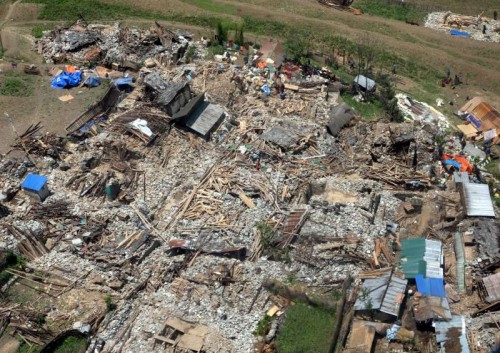
By Anil Giri
Nepal has estimated that around $10 billion worth of damage been caused by the April 25 great earthquakes and the subsequent aftershocks that rattled the Himalayan nation.
It is estimated that over one million private and public houses and buildings were damaged totally or partially. This includes damages in several other sectors like services industry, agriculture, tourism, health and education.
During the first meeting with Kathmandu-based donor communities on Friday, Finance Minister Ram Sharan Mahat put the data before seeking generous support for Nepal’s bid for rehabilitation and reconstruction.
“We are measuring the scale of damage done by the April 25 quake and the aftershocks that followed,” he said in the meeting organised held under a tent inside Nepal’s main administrative building, Singha Durbar, after his ministry’s building was sustained several cracks.
The buildings housing the Prime Minister Office, foreign ministry, defence ministry, finance ministry, National Planning Commission and several other government buildings developed cracks.
Officials in these ministries, including the President Office, Supreme Court, Nepal Army Headquarters and hundreds of other government offices are functioning from under tents and running temporary offices.
Various agencies are studying the scale of damage, Mahat told the donor community, adding that “it is our estimation that quakes have caused a loss of $5-10 billion”.
The Himalayan nation, whose annual budget is around $7 billion, is severely hurt by the series of quakes and aftershocks, prompted the government to reach out the international community for rebuilding the nation at a time when hundreds of other structures, which were damaged and destroyed during the decade-long Maoist insurgency from 1996 to 2006, were yet to be reconstructed.
Economists have predicted a grim picture of the economy as the overall GDP will he slowed by 1 to 2 percent, increase in balance of payment and major sectors of Nepal’s economy like service, real estate, manufacture , tourism, agriculture and remittance would be hit severely.
During the meeting, the government urged the international community to follow the one-window policy of the Nepal government and put money and resources through the government channel.
“We have heard that several stakeholders have announced their own way of helping for reconstruction and rehabilitation bid. We urge all of them to come through the government’s door and follow the national priority of Nepal while extending any assistance to Nepal,” Finance Secretary of Nepal, Suman Prasad Sharma said during the meeting.
However, the donor community has raised questions over government’s capability of handling the resources in an effective way, lack of spending will, inability to reach all communities, bureaucratic red-tape, inefficacy of government mechanism and high politicisation in some cases and expressing dissatisfaction with the government’s approach.
In his statement, finance minister Mahat also blamed section of the media as well as social media for criticising the government’s incapability of handling the post-quake situation and alleging that corruption was everywhere in government’s entities and hence money should not be put in the government’s basket.
“I have serious reservations over such remarks made by a section of the media which is not true. It is an elected government, holds accountability to the people and I also assure that no irregularities would take place,” said Mahat in the meeting.
While assuring cooperation with the Nepal government, members of the donor community urged the government to bring out a long-term plan for reconstruction and rehabilitation.